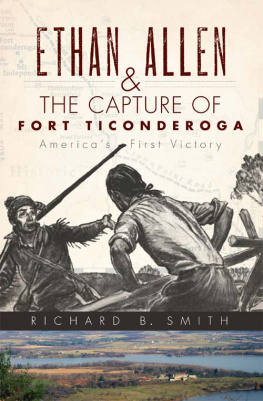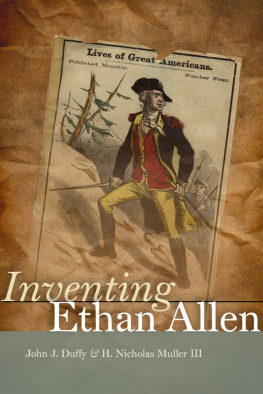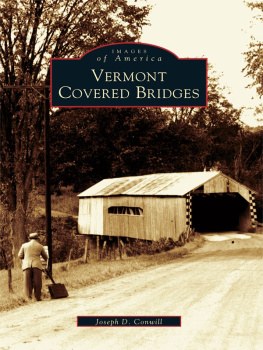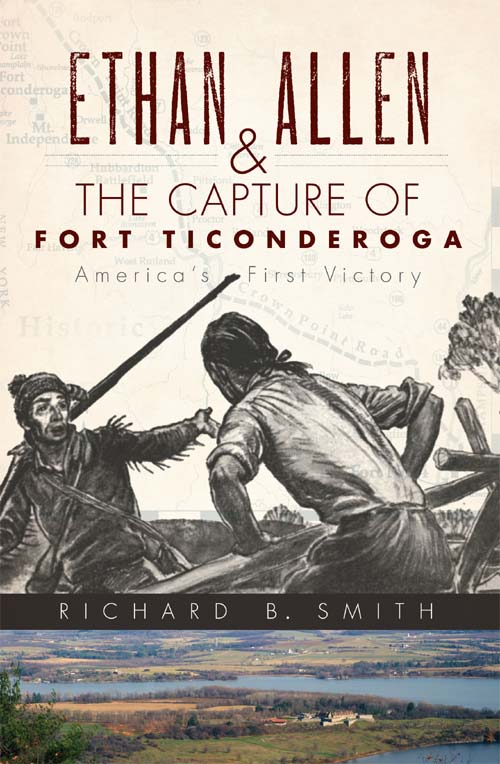ETHAN ALLEN
 &
& 
THE CAPTURE OF
FORT TICONDEROGA

Selected towns involved in the capture of Fort Ticonderoga.
ETHAN ALLEN
 &
& 
THE CAPTURE OF
FORT TICONDEROGA
RICHARD B. SMITH

Published by The History Press
Charleston, SC 29403
www.historypress.net
Copyright 2010 by Richard B. Smith
All rights reserved
Cover images: Front: Allen needs you at Ti. Reprinted by permission of National Life Group. Artwork by Herbert M. Scoops. First published in the Saturday Evening Post and Time, 1947.
The illustration protrays a Green Mountain Boy recruiting another Green Mountain Boy, as well as the clothing and armaments of the Boys at the time of the capture of Fort Ticonderoga, May 10, 1775; Fort Ticonderoga, New York. Photo by Nathan Farb. Courtesy of Fort Ticonderoga. In the distance looking east beyond Fort Ticonderoga and Lake Champlain is Vermont; Map of Crown Point Road in 1759. Courtesy of the Crown Point Road Association.
First published 2010
Second printing 2011
e-book edition 2011
ISBN 978.1.61423.108.0
Smith, Richard B.
Ethan Allen and the capture of Fort Ticonderoga : America's first victory / Richard Smith.
p. cm.
Includes bibliographical references and index.
print edition ISBN 978-1-59629-920-7
1. Fort Ticonderoga (N.Y.)--Capture, 1775. 2. Allen, Ethan, 1738-1789. 3. Arnold,
Benedict, 1741-1801. I. Title.
E241.T5S658 2010
973.3'31--dc22
2010009530
Notice: The information in this book is true and complete to the best of our knowledge. It is offered without guarantee on the part of the author or The History Press. The author and
The History Press disclaim all liability in connection with the use of this book.
All rights reserved. No part of this book may be reproduced or transmitted in any form whatsoever without prior written permission from the publisher except in the case of brief quotations embodied in critical articles and reviews.
Contents
Acknowledgements
Several individuals were helpful during the course of preparing this book by answering questions and providing information, manuscripts, artwork and books: Chris Fox, curator at the Fort Ticonderoga Association; Robert Maguire of Shoreham (Hands Cove), Vermont; Paul Carnahan, librarian of the Vermont Historical Society Library in Barre, Vermont; Ron Jones of the Salisbury Association in Salisbury, Connecticut; Heather Harrington, assistant librarian at the Historic Deerfield Library; Brian Lindner of the National Life Group in Montpelier, Vermont; Don Martin of West Pawlet; Susanne Rapport, curator of the Dorset Historical Society; Jim Purdy, Elaine Purdy and Jim Rowe of the Crown Point Road Association; Joanna Jennings of the Sheffield Historical Society; Grace Simonds, Whiting town clerk; Reverend Billy Jones of the Whiting Community Church; Charles Sullivan of the Cambridge Historical Commission; Don Sutton, Ten Hen Studio and Nancy Finlay of the Connecticut Historical Society; Carol Bosco Baumann of the Red Lion Inn in Stockbridge, Massachusetts; Catherine Bermon of the Simsbury Historical Society in Simsbury, Connecticut; Holly Hitchcock and Claire Burditt of the Castleton Historical Society; Jeremy Dibbell of the Massachusetts Historical Society; Barry Whitney of Salisbury, Vermont; Joyce Kelley and Robert Childs of the Edmund Fowle House in Watertown, Massachusetts; and a special thanks to Perez Ehrich, who provided photographic help and photos as indicated. I would also like to acknowledge those who assisted with my previous book, from which I drew some information for this book.
Several historical societies and institutions were quite helpful. Some of those were the Vermont Historical Commission, the Connecticut Historical Society, the Massachusetts Historical Society, the Cambridge Historical Society, the Manchester Historical Society (Vermont), the Dorset Historical Society, the Sheffield Historical Society, the Simsbury Historical Society, the Pawlet Historical Society, the Castleton Historical Society, the Salisbury Association, the Crown Point Road Association and the Poultney Historical Society. The Bennington Museum and the Russell Collection in Arlington were also helpful.
I would also like to thank my wife, Sharon, for her great assistance and support. Her tour business has greatly increased my love and enjoyment of history.
Introduction
Americas First Victory was the May 10, 1775 surprise capture of Fort Ticonderoga. The story of this victory is not so much a military story as a story of freedom, land and people.
This is the story of citizen soldiers without uniforms, and some unarmed, going secretly into town after town to individually recruit patriots willing to risk almost everything to try to capture the massive Gibraltar of the Americas, Fort Ticonderoga. The driving force was their dislike of tyrannyin some cases, tyranny of the land and in other cases, religious tyranny or overall tyranny of governments.
More recent information has allowed for the updating of accounts from the nineteenth and twentieth centuries of this dramatic event.
Part I
The Seeds and Forces of
Rebellion Are Created
T HINKING THE I MPOSSIBLE : C APTURING F ORT T ICONDEROGA
The massive Fort Ticonderoga, which would become known as the Gibraltar of the Americas, sits on a point high above Lake Champlain with over one hundred cannons and a star-shaped design that allows gunners to fire at any attacker from many directions. In 1758, 3,500 French defenders of Fort Ticonderoga held off about 16,000 attacking British soldiers.
Besides the physical size and design of the fort, colonial patriots in 1775 had to overcome many other obstacles, such as issues of command, lack of formal military training, lack of artillery or wall-scaling equipment and, in some cases, travel of more than two hundred milessome from as far away as Connecticut. They had to recruit one by one in areas with small populations, get spies into the fort and keep the mission a secret yet march through land filled with many Tory (Loyalist) sympathizers. They had to obtain boats to cross Lake Champlain itself, worry about reinforcements from Canada and risk the possibility of losing their own land even if they won. How Fort Ticonderoga was captured by fewer than three hundred citizen soldiers and the story of the people who had become so oppressed to even attempt this can be found in the history of settlement of the early American colonists.











 &
& 
